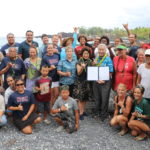Governor David Ige recently signed administrative rules making the coastline bordering Miloliʻi Village the State’s second Community-Based Subsistence Fishing Area (CBFSA).
Miloli‘i CBSFA will protect and conserve fish populations and their habitats, by combining traditional Hawaiian fishing practices with modern approaches to conservation.
Act 271, enacted by the State Legislature in 1994, led to the designation of 18-miles of coastal waters along the rugged coastline on either side of the small community as the first permanent, legislatively designated CBSFA. Years of work by dedicated community members, with support from biologists and staff at the DLNR Division of Aquatic Resources (DAR) and research and non-governmental organizations, led to the development of a set of administrative rules designed to ensure abundant stocks of priority species and high-quality fishing now and into the future.
Laila Kaupu, a fifth generation Miloli‘i fisher, was one of the prime movers behind the CBSFA initiative and headed up the community group, Kalanihale, which was instrumental in the development of the rules.
In remarks before signing the administrative rules into law, Governor Ige said, “We need young people to carry this work forward and encourage other communities to create community-based subsistence fishing areas for the benefit and future of the entire state. Miloli‘i is a shining example of how we can all work together for the benefit of our marine resources, our keiki and our kupuna.”
In 2015, the Hāʻena CBSFA was established on Kauaʻi. In 2016 the Kaʻūpūlehu “Try Wait” community-led marine rules were passed on Hawaiʻi Island. These communities, with Miloliʻi, have inspired communities across the state to propose rules with the DAR to sustain Hawaiʻi’s marine resources.
Photo credit: DLNR
